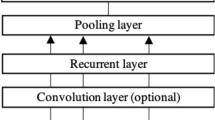Abstract
Automated essay grading has become an important area of research in natural language processing. In this paper, we present a new approach for essay grading using BERT language model with Convolutional Neural Networks and Long Short-Term Memory networks on the Automated Student Prize Assessment dataset. The proposed essay grader evaluates essays based on several writing traits such as grammatical mistakes, semantics, coherence, prompt relevance, and others and provide a score for each trait. We evaluate the performance of our model on a fairly large dataset of essays and compare its performance with existing state-of-the-art models. Our results demonstrate the effectiveness of our proposed approach for automated essay grading, achieving high accuracy and improving on the performance of existing models.
Access this chapter
Tax calculation will be finalised at checkout
Purchases are for personal use only
Similar content being viewed by others
References
Taghipour K, Ng HT (2016) A neural approach to automated essay scoring. In: 2016 EMNLP. https://aclanthology.org/D16-1193
Attali Y, Burstein J (2006) Automated essay scoring with e-raterR v. 2. J Technol Learn Assess 4(3)
Yang Y, Xia L, Zhao Q (2019) An automated grader for Chinese essay combining shallow and deep semantic attributes. IEEE Access 7:176306–176316. https://doi.org/10.1109/ACCESS.2019.2957582
Pedersen T, Patwardhan S, Michelizzi J (2004) Wordnet: similarity: measuring the relatedness of concepts. In: Demonstration papers at HLTNAACL 2004, Boston, Massachusetts. Association for Computational Linguistics, Stroudsburg, PA, pp 38–41
Prabhu S, Akhila K, Sanriya S (2022) A hybrid approach towards automated essay evaluation based on Bert and feature engineering. In: 2022 IEEE 7th international conference for convergence in technology (I2CT), pp 1–4. https://doi.org/10.1109/I2CT54291.2022.9824999
Liu J, Xu Y (2019) Automated essay scoring based on two-stage learning. https://doi.org/10.48550/arXiv.1901.07744
Phandi P et al (2015) Flexible domain adaptation for automated essay scoring using correlated linear [regression]. In: 2015 EMNLP. https://aclanthology.org/D15-1049
Heilman M, Madnani N (2013) ETS: domain adaptation and stacking for short answer scoring. In: Proceedings of the seventh international workshop on semantic evaluation
Chen H, He B (2013) Automated essay scoring by maximizing human-machine agreement. In: Proceedings of the 2013 Conference on empirical methods in natural language processing
Larkey LS (1998) Automatic essay grading using text categorization techniques. In: Proceedings of the 21st annual international ACM SIGIR conference on research and development in information retrieval. ACM, pp 90–95
Alqahtani A, Alsaif A (2019) Automatic evaluation for arabic essays: a rule-based system. In: 2019 IEEE international symposium on signal processing and information technology (ISSPIT), pp 1–7. https://doi.org/10.1109/ISSPIT47144.2019.9001802
Näther M (2020) An in-depth comparison of 14 spelling correction tools on a common benchmark. In: 2020 LREC. https://aclanthology.org/2020.lrec-1.228
Sindhu C, Vadivu G (2021) Fine grained sentiment polarity classification using augmented knowledge sequence-attention mechanism. J Microprocess Microsyst 81
Wang Y et al (2022) On the use of Bert for automated essay scoring: joint learning of multi-scale essay representation. In: NAACL 2022. https://aclanthology.org/2022.naacl-main.249
Li X, Liu J (2016) Automatic essay scoring based on Coh-Metrix feature selection for Chinese English learners. SETE@ICWL
Shermis MD, Burstein JC (2002) Automated essay scoring: a cross-disciplinary perspective. Lawrence Erlbaum
Author information
Authors and Affiliations
Corresponding author
Editor information
Editors and Affiliations
Rights and permissions
Copyright information
© 2023 The Author(s), under exclusive license to Springer Nature Singapore Pte Ltd.
About this paper
Cite this paper
Vanga, R.R., Sindhu, C., Bharath, M.S., Reddy, T.C., Kanneganti, M. (2023). Autograder: A Feature-Based Quantitative Essay Grading System Using BERT. In: Tuba, M., Akashe, S., Joshi, A. (eds) ICT Infrastructure and Computing. ICT4SD 2023. Lecture Notes in Networks and Systems, vol 754. Springer, Singapore. https://doi.org/10.1007/978-981-99-4932-8_8
Download citation
DOI: https://doi.org/10.1007/978-981-99-4932-8_8
Published:
Publisher Name: Springer, Singapore
Print ISBN: 978-981-99-4931-1
Online ISBN: 978-981-99-4932-8
eBook Packages: Intelligent Technologies and RoboticsIntelligent Technologies and Robotics (R0)




